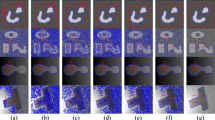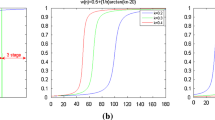Abstract
A novel integrated two-stage approach is proposed for image segmentation, where the edge, global and local region information of images are in turn incorporated to define the intensity fitting energy. In the first stage, the Chan-Vese model flexibly assimilates the edge indicator function in the beginning, and then the Laplace operator is introduced to regularize the level set function when minimizing the energy functional. As an edge-based and global region-based active contour, it can be inclined to rapidly produce a coarse segmentation result. In the second stage, we further segment the image by absorbing the local region fitting energy, where its initialization is acquired by the final active contour of the first stage. In addition, we present a generalized level set regularization term, which efficiently eliminates the periodically re-initialization procedure of traditional level set methods and maintains the corresponding signed distance property. Compared with the first stage, the local object details are accurately segmented in the second stage, which can acquire an accurate segmentation result. Qualitative and quantitative experimental results demonstrate the accuracy, robustness and efficiency of our approach with applications to some synthetical and real-world images.











Similar content being viewed by others
References
Caselles V, Kimmel R, Sapiro G (1997) Geodesic active contours. Int J Comput Vis 22(1):61–79
Chan TF, Vese LA (2001) Active contours without edges. IEEE Trans Image Process 10(2):266–277
Comaniciu D, Meer P (1999) Mean shift analysis and applications. In: Proceedings of the Seventh IEEE International Conference on Computer Vision, vol 2. IEEE, pp 1197–1203
Darolti C, Mertins A, Bodensteiner C, Hoffman UG (2008) Local region descriptors for active contours evolution. IEEE Trans Image Process 17(12):2275–2288
Faisal A, Ng S-C, Goh S-L, Supriyanto E, Lai KW (2015) Multiple LREK active contours for knee meniscus ultrasound image segmentation. IEEE Trans Med Imaging 34(10):2162–2171
Felzenszwalb PF, Huttenlocher DP (2004) Efficient graph-based image segmentation. Int J Comput Vis 59(2):167–181
He K, Gkioxari G, Dollár P, Girshick R (2017) Mask r-cnn. In: Proceedings of the IEEE International Conference on Computer Vision. IEEE, pp 2961–2969
Kass M, Witkin A, Terzopoulos D (1988) Snakes: active contour models. Int J Comput Vis 1(4):321–331
Kim J, Fisher JW, Yezzi A, Cetin M, Willsky AS (2005) A nonparametric statistical method for image segmentation using information theory and curve evolution. IEEE Trans Image Process 14(10):1486–1502
Kong S, Fowlkes C.C.: (2018) Recurrent pixel embedding for instance grouping. In: Proceedings of the IEEE Conference on Computer Vision and Pattern Recognition. IEEE, pp 9018–9028
Lang F, Yang J, Yan S, Qin F (2018) Superpixel segmentation of polarimetric synthetic aperture radar (sar) images based on generalized mean shift. Remote Sens 10 (10):1592
Lankton S, Tannenbaum A (2008) Localizing region-based active contours. IEEE Trans Image Process 17(11):2029–2039
Li C, Xu C, Gui C, Fox MD (2005) Level set evolution without re-initialization: a new variational formulation. In: Proceedings of IEEE Conference on Computer Vision and Pattern Recognition. IEEE, San Diego
Li B, Acton ST (2007) Active contour external force using vector field convolution for image segmentation. IEEE Trans Image Process 16(8):2096–2106
Li C, Kao C, Gore JC, Ding Z (2008) Minimization of region-scalable fitting energy for image segmentation. IEEE Trans Image Process 17(10):1940–1949
Li C, Xu C, Gui C, Fox MD (2010) Distance regularized level set evolution and its application to image segmentation. IEEE Trans Image Process 19(12):3243–3254
Li D, Li W, Liao Q (2013) Active contours driven by local and global probability distributions. J Vis Commun Image Represent 24(5):522–533
Li W, Li F (2019) A level set image segmentation method based on a cloud model as the priori contour. SIViP 13(1):103–110
Liu J, Wei X, Li L (2020) MR Image segmentation based on level set method Multimedia Tools and Applications, Springer, Multimedia Tools and Applications, pp. 1–16. https://doi.org/10.1007/s11042-019-08468-2
Min H, Jia W, Zhao Y, Zuo W, Ling H (2018) LATE: A Level-set method based on local approximation of Taylor expansion for segmenting intensity inhomogeneous images. IEEE Trans Image Process 27(10):5016–5031
Mumford D, Shah J (1989) Optimal approximations by piecewise smooth functions and associated variational problems. Commun Pur Appl Math 42(5):577–685
Niu S, Chen Q, De SL, Ji Z, Zhou Z (2017) Robust noise region-based active contour model via local similarity factor for image segmentation. Pattern Recogn 61:104–119
Osher S, Sethian JA (1988) Fronts propagating with curvature-dependent speed: algorithms based on Hamilton-Jacobi formulation. J Comput Phys 79(1):12–49
Shi J, Malik J (2000) Normalized cuts and image segmentation. IEEE Trans Pattern Anal Mach Intell 22(8):888–905
Sussman M, Fatemi E (1999) An efficient, interface preserving level set redistancing algorithm and its application to interfacial incompressible fluid flow. SIAM J Sci Comput 20(4):1165–1191
Vese LA, Chan TF (2002) A multiphase level set framework for image segmentation using the Mumford and Shah model. Int J Comput Vis 50(3):271–293
Wang L, He L, Mishra A, Li C (2009) Active contours driven by local Gaussian distribution fitting energy. Signal Process 89(12):2435–2447
Wang L, Li C, Sun Q, Xia D, Kao C (2009) Active contours driven by local and global intensity fitting energy with application to brain MR image segmentation. Comput Med Imaging Graph 33(7):520–531
Wang H, Huang T-Z, Xu Z, Wang Y (2014) An active contour model and its algorithms with local and global Gaussian distribution fitting energies. Inf Sci 263:43–59
Wang H, Huang T-Z, Xu Z, Wang Y (2016) A two-stage image segmentation via global and local region active contours. Neurocomputing 205:130–140
Xie X, Mirmehdi M (2008) MAC: Magnetostatic Active contour model. IEEE Trans Pattern Anal Mach Intell 30(4):632–646
Xie X (2010) Active contouring based on gradient vector interaction and constrained level set diffusion. IEEE Trans Image Process 19(1):154–164
Zhang K, Song H, Zhang L (2010) Active contours driven by local image fitting energy. Pattern Recogn 43(4):1199–1206
Zhang K, Zhang L, Song H, Zhang D (2013) Re-initialization free level set evolution via reaction diffusion. IEEE Trans Image Process 22(1):258–271
Zhang W, Wang X, You W, Chen J, Dai P, Zhang P (2020) RESLS: Region And edge synergetic level set framework for image segmentation. IEEE Trans Image Process 29(1):57–71
Zhao X-L, Wang F, Ng MK (2014) A new convex optimization model for multiplicative noise and blur removal. SIAM J Imaging Sci 7(1):456–475
Zhu SC, Yuille A (1996) Region competition: unifying snakes, region growing, and bayes/MDL for multiband image segmentation. IEEE Trans Pattern Anal Mach Intell 18(9):884–900
Acknowledgements
This research is supported by the Union Program of Science Technology of Guizhou Province, Anshun Government and Anshun University (LH20157699), the Natural Science Research Foundation of Guizhou Education Department (KY2018070), the Natural Science Foundation of China (11601010), and the Natural Science Research Foundation of Guizhou Education Department (KY2018034).
Author information
Authors and Affiliations
Corresponding author
Additional information
Publisher’s note
Springer Nature remains neutral with regard to jurisdictional claims in published maps and institutional affiliations.
Rights and permissions
About this article
Cite this article
Wang, H., Du, Y. & Han, J. An integrated two-stage approach for image segmentation via active contours. Multimed Tools Appl 79, 21177–21195 (2020). https://doi.org/10.1007/s11042-020-08950-2
Received:
Revised:
Accepted:
Published:
Issue Date:
DOI: https://doi.org/10.1007/s11042-020-08950-2




